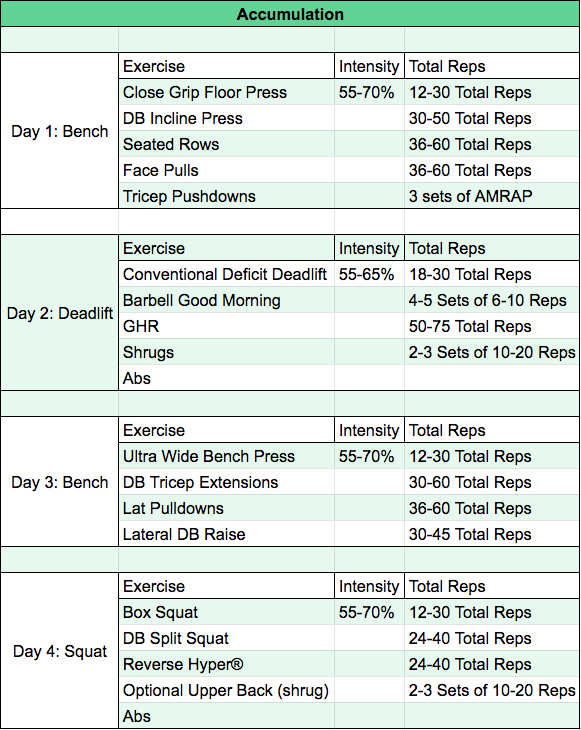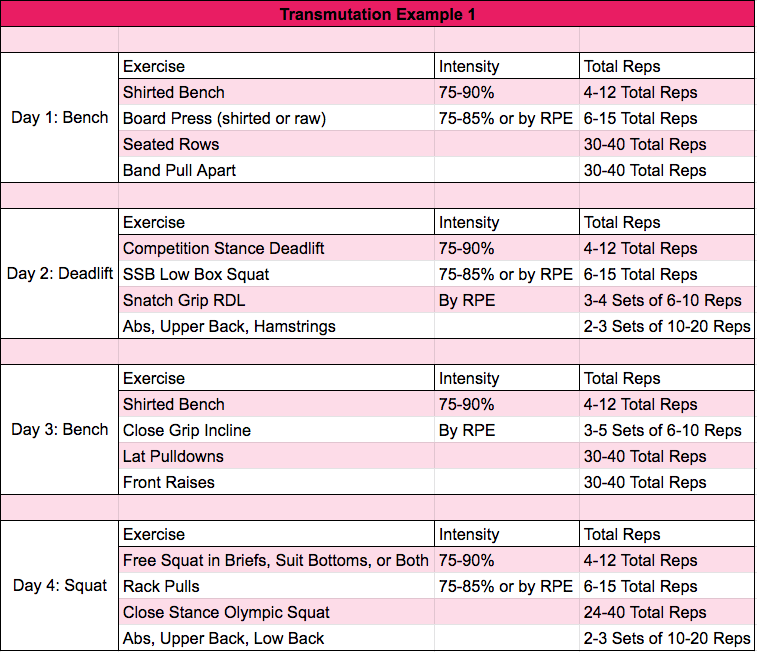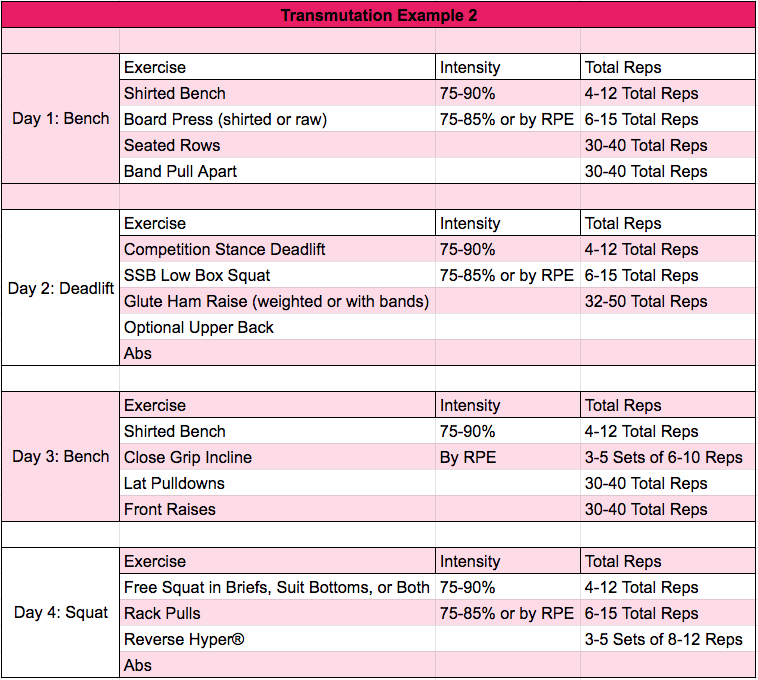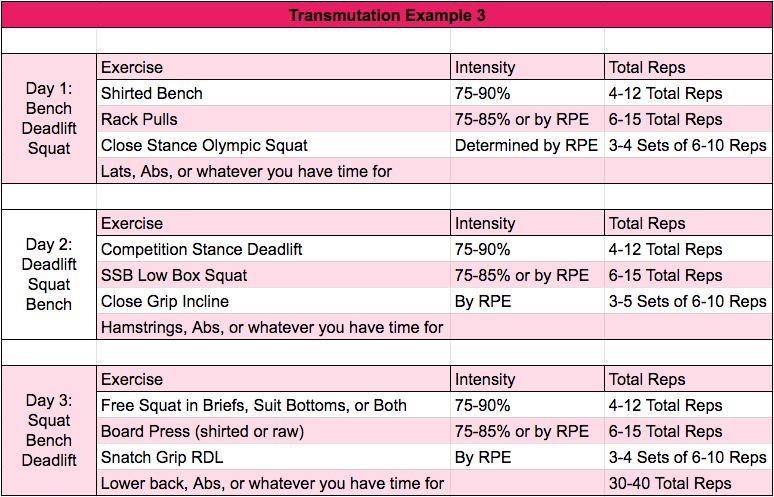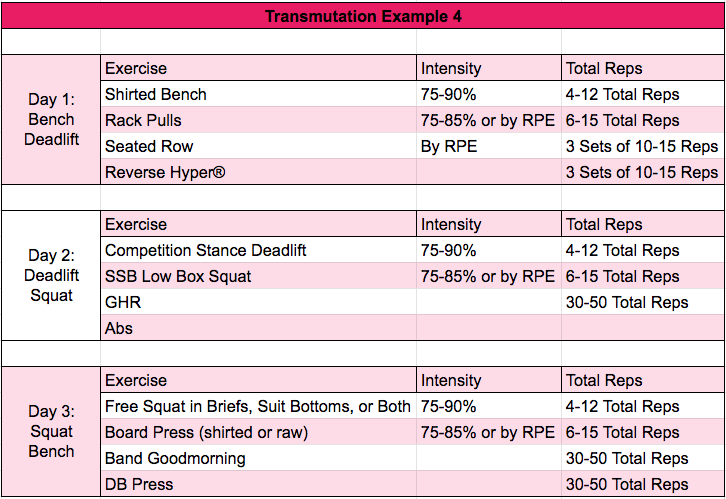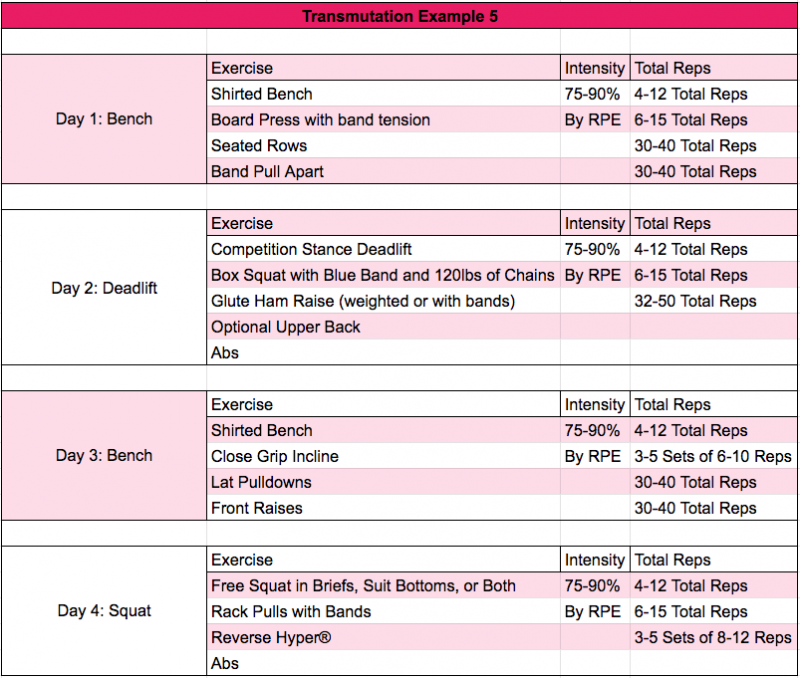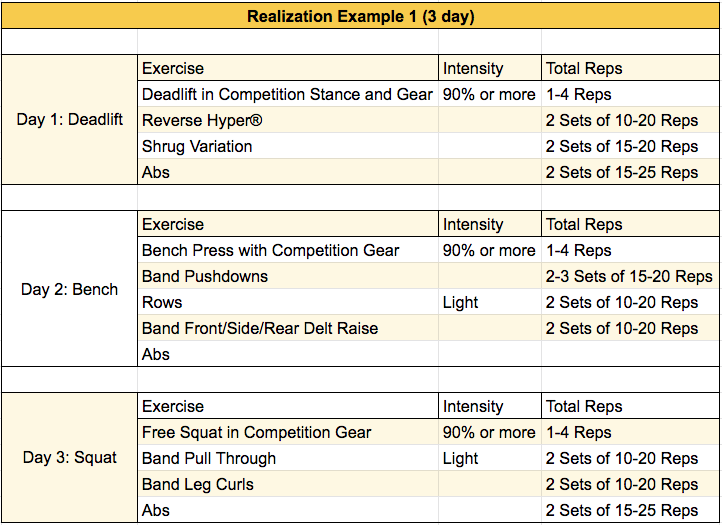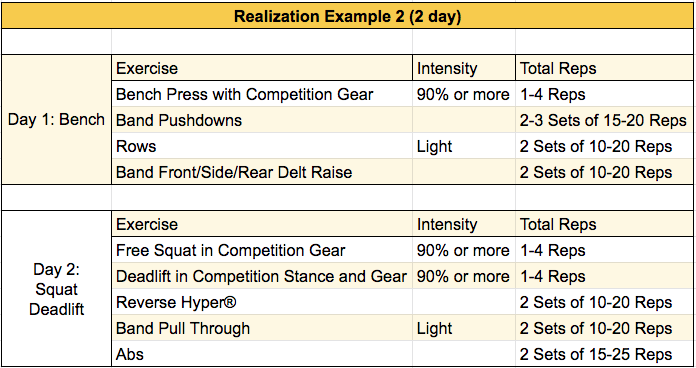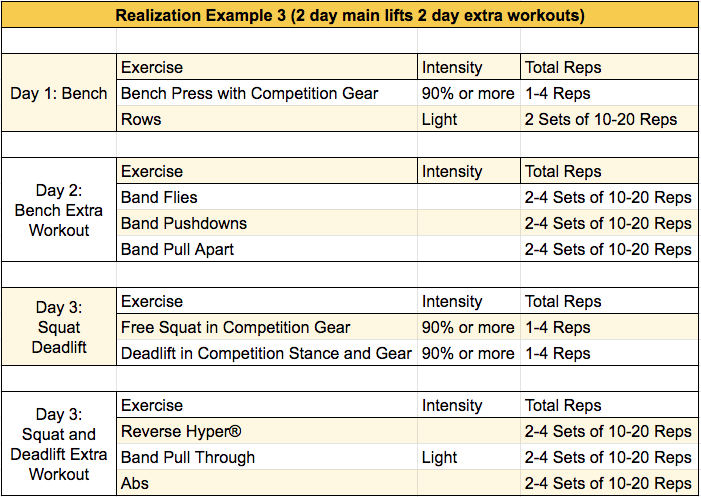Powerlifting is a sport that is tailor-made for Block Periodization. This is due to the small number of physical traits that must be trained for: maximal strength, absolute strength, and technique. This article is directed toward the average lifter, not the physical preparation coach. The intent is not to discuss the hard science behind the system. The purpose is to outline the principles of the system and how to implement these principles in a practical sense.
How I Learned of Block Periodization
I first became aware of Block Periodization while interning under Buddy Morris and James Smith at the University of Pittsburgh. James presented some information on the Block system to me, and while I found it interesting, I was skeptical as it seemed to be different from what I was doing. I also didn’t have a full understanding of the terminology and how to implement it. During this time, I was still using a Westside Barbell-style system of programming. I was reluctant to change, as this system had given me gains in the past. I continued to use a lot of the principles of Westside but had a lot of injuries. I also was very inconsistent because I was rarely performing the competition lifts.
After a string of injuries and bomb outs, I took some time away from powerlifting. After moving to Washington, DC, I met Carlos Osegueda, who runs Central Virginia Athletic and Barbell Club. He had been training with the Block Periodization system and making progress. At this time, I decided to research by reading Issurin’s Block Periodization: A Breakthrough in Sports Training and Principles and Basics of Advanced Athletic Training. These books gave me a better understanding, and for the next year, I used trial and error along with the knowledge I gained to fine-tune the programming to fit my needs. Using this system, I set a 190-pound total PR and gained my first Elite at 242.
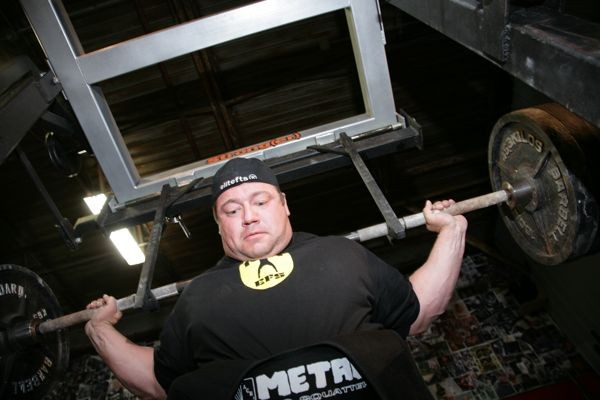
What is Block Periodization?
The technical definition, as Issurin states, “The general approach to the compilation of Block Periodized training assumes the sequencing of three different-type mesocycle-blocks that form a single training stage ending in some competition.” In practical terms, it's a system of focusing on general abilities further out from a meet and becoming more directed as the competition draws near. That being said, it's necessary to know how to classify movements as general, general specific, or specific. From here, a lifter can lay out the blocks based on movements that fit into each category and target the weaknesses of each lifter. Because of this, two lifters using a Block system may have training sessions that look completely different. The only absolute is that the programming fits within the guidelines of the three blocks: accumulation, transmutation, and realization.
Accumulation
To give an example of the accumulation block, it would be like building a foundation for a house. The intensity is reduced, but there are higher volumes of work. The work during this block will also have a greater amount of general and general specific. It will have less specific movements. In the sport of powerlifting, the purpose of a block like this would be to promote hypertrophy and increase work capacity.
The percentages for this block depend on the lifter but generally range from 50-70 percent. When I calculated the volume for this block, I used Prilepin's chart as a guideline, but it's not set in stone. The duration of this block can range from two to six weeks. Again, much of this depends on the lifter and their level of preparation. The less qualified, the longer the block can be. The length can vary depending on where this block falls in the annual plan. A restoration/deload isn't necessary after this block but may be included depending on the individual.
Transmutation
The basis of the transmutation block is to take the general abilities and transfer them to specific abilities. During this phase, the intensity increases, and the volume is reduced, but still is considered moderate. The movements in this block start to include the specific/competition lifts, but also have a large volume dedicated towards general specific lifts that build the competition movements. General exercises won't be prioritized but may be included at a reduced volume. The goal of this block is to develop the abilities that are specific to the competition lifts. Percentages used during this block generally fall between the 75-90 percent range.
Again, I based this on Prilepin’s chart, but sometimes the workload can be higher or lower. The duration of this block is somewhere in the two- to four-week range. The length is determined by the qualification of the lifter and where the block falls in the annual plan. The further out, the longer this block can be used. Another aspect of this block is that it's designed to induce fatigue. There won't be full recoveries between training sessions. In layman’s terms, it's normal to feel like shit during this block, but you should still be able to hit all of the numbers you planned to hit. This is by far the most difficult block of all. Pay attention to volume and intensity because it's very easy to become overtrained. This block needs to be followed by a restoration/deload.
Realization
The realization block is the final stage of training before a meet. The volume is low and the intensity is high. Because of this, it's often referred to as a taper. During this block, the training is directed to the competition lifts. The general specific lifts are phased out and if any general exercises are included, they're for the purpose of injury prevention or light flushing/pumping work. The percentages used are 90 percent or greater. Lifts should be performed to the standards that are needed in competition. There should be full recoveries between sessions. The frequency of training is also decreased during this block. The duration is shorter and usually is around two weeks. This should be followed by a restoration/deload lasting one to two weeks, depending on personal preference.
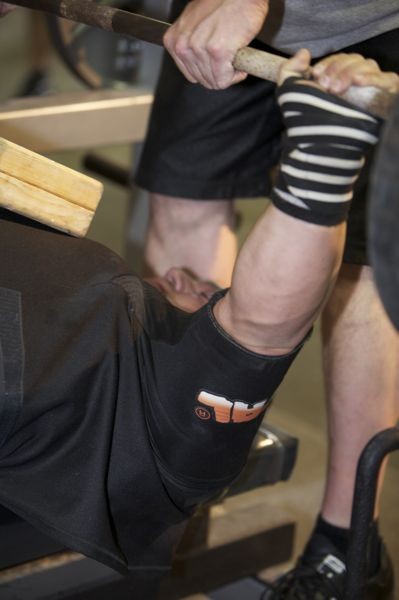
Putting It All Together
Ok, so if you made it this far, you’ve read all my inane rambling and are still with me. You might be thinking, “All I give a shit about is getting a big total. How do I set this up so I can do that?” I have some bad news - I can’t give an exact answer. I don’t know your particular weaknesses, technical errors, levels of preparation, how many days a week you can train, etc. I can give you examples of a few different ways to set this up, and then you can tailor the principles to fit your needs. I'll use some examples of what I've done and what has worked for me. I'll also offer some alternatives. Again, this is to provide an example. Don't think this should be taken literally. I also didn't include warm-ups, restoration work, prehab/rehab, and so on because this differs for everyone.
Accumulation
Keeping with the definition of the block, I provided an example to aid in planning. I used total reps on both the general specific movements and the general movements because some people like certain rep schemes better or have different needs.
Maybe Lifter A needs more hypertrophy, so he may elect to do his close grip or box squat at the upper limits of Prilepin’s chart or even decide to exceed it and attempt to get all of his reps in as few sets as possible.
Lifter B might have difficulty accelerating a load and will use a traditional “DE” style approach and go with ten sets of two on his box squats. The same goes for the general work such as DB Presses, rows, glute hams, etc. These exercises are just examples and all can be substituted if they fit the classifications. I've used bands and chains during this block, but the extra tension or weight may need to be accounted for.
As far as percentages go, you can go in a linear progression over the duration of the block. It can also be flat-loaded, meaning maybe you stay at 12 - 15 total reps at 70 percent for the whole block, but week one is 3 x 5, week two is 5 x 3, and week three is 7 x 2. As far as equipment, it can be used during this block. In the past, I've done this raw for the fact that as far away from a meet as it is, I don't feel the need to use gear. If you're trying to promote hypertrophy and work capacity, the less gear, the better.
Transmutation
This block can cause a lot of confusion as far as planning is concerned. Due to this, I included numerous templates that can be used. In reference to the percentages, they're a guideline to use but may need to be adjusted. A variable that skewers the numbers can be the addition of gear. It's very important to base the numbers on a realistic training max. During the specific movements, technique should be observed to determine the optimal number of reps/sets. Also, make sure you're basing the percentages on the actual exercise you're performing.
Don't be the moron who attempts to base a special exercise off of a competition squat and then wonders why they got stapled. Now, you might be thinking, “Alright, smartass. You made your point, but there's a problem. I don’t know my actual maxes on special exercises. Now what?” This is where RPE comes into play. The abbreviation RPE stands for Rate of Perceived Exertion. This is nothing more than a fancy way of saying “training by feel.” On these sets, you should be working, but you should be able to finish the sets. During a transmutation block, most of the sets in the specific and general specific exercises should fall somewhere between the scale of 7-10 on the chart. Again, this is a guideline and the police will not issue a warrant if you venture out of this range.
This is a basic four day split for a transmutation block. The information is for a lifter that is competing geared. If competing raw, disregard the gear suggestions but still use the percentages and rep schemes. The work becomes more directed as the movements are the competition lifts or their variants. On the bench days, rowing and pulling are kept in, but the volume is reduced from the accumulation block. On squat days, the main movement is the competition squat, followed by a general specific movement for the deadlift, followed by another general specific movement for the squat with reduced intensities. The deadlift day follows the same template, except with a DL-SQ-DL setup. Both days have general work done in a circuit at the end to maintain GPP. This may or may not need to be cut depending on feel. The intensity of this work should be low.
There are pros and cons to this setup. The pros are the amount of specific and general specific work will have a higher transference to the competition lifts. These lifts also stress training economy as they give a lot of bang for your buck. The cons of a setup like this are that it's very time-consuming. Using big, compound lifts requires more attention to technique. Because of this, more rest is needed between sets. Also, the four-day split may not work for everyone because of the time it may take. For some lifters, this split may be too much to recover from. For others, they may need more general work for a particular area due to injury history, particular weakness, etc.

Here's a variation of the four-day split above. The bench days are the same, but the squat and deadlift days have been altered.
As you can see, there is less general specific work in this template. It's less time-consuming for those who let that nagging problem called "real life" get in the way and is easier to recover from for some who have a propensity for overtraining or injuries. You can also plug in more general work for particular weak areas.
Some of you may have even more obligations that mean you can only train three days a week. Since quitting your job and leaving your family might not be an option, you may want to use a setup like this. This would work if the powers that be (work, family, etc.) allow you three days to train, and time isn't an issue on those three days. This would also be good if you feel you recover well and want to use specific and general specific work. An added bonus is that it will prepare you for a meet due to the three lifts being trained either specifically or with a general specific variant.
If you only have three days and have limited time, the following setup may be best. This won’t have all of the general specific work but will follow a similar setup as is outlined above.
Now, one last template you may want to use. I know accommodating resistance is popular among a lot of powerlifters. This is especially true in multi-ply federations. I suggest you don't use bands on the specific exercises. The point of doing these lifts is to refine technique and the bands will alter the motor patterns. Chains are a gray area. They can be used on specific exercises, but in most cases, it's better to use them on the general specific lifts. To give an example, this could work as a variation of a four-day variation using chains and bands on the general specific lifts. The reason I used RPE is that it's hard to give a percentage because of fatigue from the main movement. When you add in the extra tension from bands or weight from chains, it can become even harder to pinpoint.
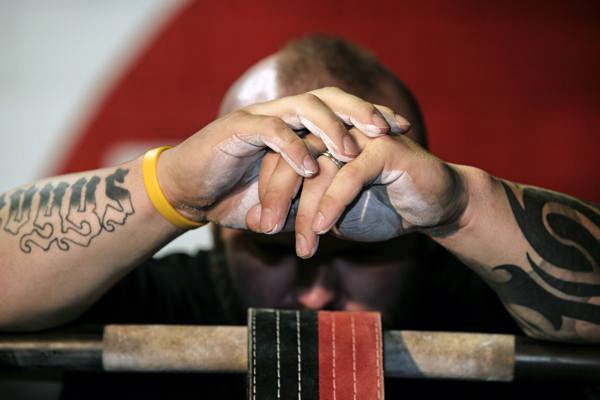
Realization
Realization is the final piece of the puzzle. This block will have low volume, high intensity, and full recoveries between workouts. It generally runs for two weeks. During this block, some lifters may choose to dedicate a separate day for each lift. Some may decide to only have two main days, with one for the bench and one for the squat/deadlift. After the specific movement, some light general accessory work can be performed. The volume and intensity of this work should be low. I'll demonstrate a basic realization block using each setup. With this setup, each lift has a dedicated day with some light accessory work after. The purpose of the accessory work is to flush some blood and act as light GPP. It should not be heavy or taxing.
Some lifters may opt for only having two main training days during this block. If this is the case, they'll have one bench day and a day for the squat and deadlift. Here's one way to set this up:
Another way that may be used to set this up would be doing the general accessory work on a separate day. Remember, the extra workouts are light and used to enhance recovery.
Setting Up a Training Cycle
When using Block Periodization leading up to a contest, it's important for a lifter to know how many weeks total they have. It may be best to work backward from the meet. This will allow the lifter to have a guideline of how long each block should run, when equipment should be added, when to take restoration/deload weeks, and how to adjust if changes need to be made.
Below is an 18-week training cycle. The blocks are designated, as well as when certain gear will be used. These are merely suggestions and will depend on the lifter’s skill in the gear as well as training needs. It's written working backward from the meet.
- Week 1: Meet week
- Week 2: Restoration/Deload
- Week 3: Realization (full gear)
- Week 4: Realization (full gear)
- Week 5: Restoration/Deload
- Week 6: Transmutation (bench shirt, briefs, suit, or both at lifter discretion)
- Week 7: Transmutation (bench shirt, briefs, suit, or both at lifter discretion)
- Week 8: Restoration
- Week 9: Accumulation (Raw)
- Week 10: Accumulation (Raw)
- Week 11: Accumulation (Raw)
- Week 12: Restoration/Deload
- Week 13: Transmutation (Raw or limited/loose gear)
- Week 14: Transmutation (Raw or limited/loose gear)
- Week 15: Restoration/Deload
- Week 16: Accumulation (Raw)
- Week 17: Accumulation (Raw)
- Week 18: Accumulation (Raw)
Block Periodization is not a one-size-fits-all training system. It is not a matter of sets x reps, exact exercises, and personal beliefs. It's an organizational outline that classifies means of preparation from general to specific. To successfully implement this system, a lifter must be able to thoughtfully place particular exercises into blocks that correspond with the principles of general preparation, general specific preparation, and specific preparation.
By having an understanding of this style of programming, a lifter will be able to take advantage of the general qualities gained from the early stages of training by promoting transference to the competition squat, bench, and deadlift. I hope this article has stimulated some thought and cleared up the misconceptions about Block Periodization.
Originally published on Aug 6th, 2010
References
- Issurin, V. (2008) Principles and Basics of Advanced Athletic Training. Ultimate Athlete Concepts: Michigan.
- Issurin, V. (2008) Block Periodization: A Breakthrough in Sports Training. Ultimate Athlete Concepts: Michigan.
- Smith, J. Classification of the Means. https://www.elitefts.com/documents/classification_of_the_means.pdf
- Kontos, T. Prilepin’s Chart. https://www.elitefts.com/documents/prilepins_chart.htm
- Tuchscherer, M. Rate of Perceived Exertion (RPE). https://www.elitefts.com/documents/perceived_exertion.htm
Block Periodization is not a one-size-fits-all training system. It is not a matter of sets x reps, exact exercises, and personal beliefs.









